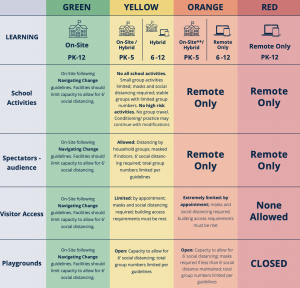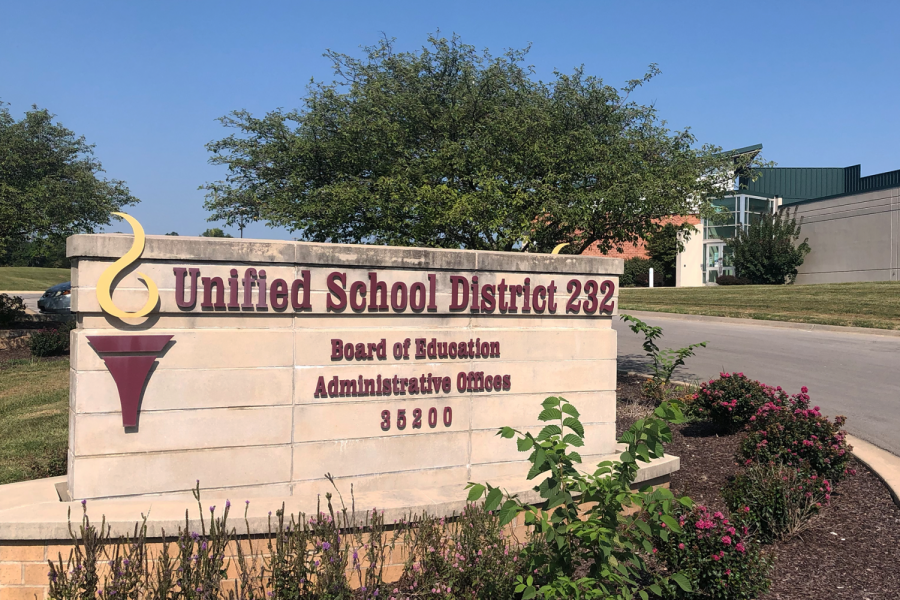Board approves gating criteria, opts for hybrid model reopening
After a five-hour, 41-minute meeting, the board approved KSDE gating criteria for school models and voted to reopen in the hybrid model at all grade levels
By Ben Wieland
A photo of the district office building the morning before Monday, Aug. 24th’s board meeting. At the meeting, the board discussed gating criteria for reopening.
August 25, 2020

After five experts, six hours and seven proposals, the Board of Education finally approved gating criteria for the district’s reopening plan and made a decision about what the first day of school will look like.
The board voted 4-3 to approve the Kansas State Department of Education’s gating criteria for reopening school and 6-1 to reopen in the criteria’s yellow model — a choice that means all students will return to school in the hybrid model Tuesday, Sept. 8.
The board also formed an advisory board to make future decisions on which learning model the district will follow; parents and students will also be given the choice once more to switch to optional remote learning.
The decision, which deviated from districts like Shawnee Mission and Blue Valley that chose to more strictly follow health department recommendations, reflected the will of district parents who spoke at the meeting and advocated for a full in-person reopening.
Board member Rachele Zade summed up the board’s decision to ignore the recommendations of health professionals and send all students back to school in the hybrid model.
“I know this decision is emotional, and it doesn’t reflect the numbers, but decisions cannot be made on just numbers,” Zade said.
Pediatricians and doctors who spoke at the meeting advocated for elementary students to return in a hybrid model and older students to remain online. One pediatrician, Lisa Gilmer, outlined how she would balance concerns about safety and emotional well-being for students.
“All efforts should be made to get elementary students back to on-site learning as soon as possible in a safe manner,” Gilmer said. “There are so many benefits to being in school, but at no time do we want students to be in school if it is not safe.”
Epidemiologist Elizabeth Smith urged the board to limit extracurricular activities as well, citing the high risk of virus transmission within the community.
“If this were the NBA and we could put our sports teams in a bubble, that would be great,” Smith said. “But we can’t do that. Each extracurricular activity reflects an opportunity for the virus to spread.”
Another pediatrician, Kari Harris, expressed concern for student mental health but said that due to the spread of COVID “we have to think very creatively about coming up with options for extracurriculars.”
The board ultimately declined to heed these warnings, choosing instead to move forward with their plan to reopen all activities without restrictions. Board member Rick Amos saw the board’s decision as a sign of leadership.
“Other districts are running scared and we want to be the one that leads [by reopening],” Amos said.
The board’s decision on school reopenings was not in agreement with the recommendation of the De Soto Teachers’ Association, either; in a letter to the board, DTA advised that they follow the recommendations of medical health professionals instead of the desires of teachers or parents.
“It is the teachers union’s belief that the opinions of neither teachers or patrons should be considered in the reopening decision. That decision can only be made by qualified health professionals,” DTA president Emily Valdez said. “Thus, DTA recommends that the board adopt Johnson County’s gating criteria as the minimum standard for reopening.”
Valdez also presented statistics during the meeting from a teacher survey. The data showed that 49% of teachers wanted to return in a remote model, as opposed to 31% who preferred hybrid and 20% who wanted a full in-person return; survey data also revealed that 49% of teachers are either personally at high risk for COVID or have a family member who is at high risk.
While medical advice at the meeting suggested that the board take a cautious approach to its reopening plan, patron input was heavily skewed towards making a quicker return to in-person learning.
Patrons from throughout the district spoke, a majority of whom advocated for in-person school and questioned the data and science provided. Jason Stenberg, the husband of a teacher in the district, summed up the arguments of in-person advocates with his three-minute speech.
“I’ve listened to a lot of doctors, and you might be swayed by their expertise. I myself am a firefighter. I have a strong background in numbers. I urge you to not listen to doctors,” Stenberg said. “I’ve heard doctors talk about COVID this, masks that. Please do not just listen to the experts.”
Other speakers argued against the remote model, citing mental health risks and unstable at-home situations as reasons a return to school was necessary. A few speakers, like freshman Emma Clement, sided with the medical professionals who opened the meeting.
“I really like school. I like learning, seeing my friends, and play sports. I could stand here all day and tell you how much I want to go back to school in person. But that’s not what this decision is about,” Clement said. “This decision isn’t about just me. It’s about our older relatives, or anyone with a chronic illness, or teachers who will be put at risk. If we go back to school without listening to our health professionals, we are at high risk of an outbreak.”
The board ultimately considered many different proposals — adopting Johnson County’s gating criteria, developing criteria unique to the district, or even rejecting all gating criteria. After three failed votes, the proposal to adopt KSDE’s criteria, which are slightly more lenient than Johnson County’s, won out.
The board’s next meeting will take place Monday, Sept. 14.











Michelle • Aug 25, 2020 at 7:27 pm
I’m happy that parents & students who want remote learning & parents & teachers who want in person learning can have a happy medium.
Still looking forward to full time in person learning as an option.
The quicker we can treat our children’s education as a necessity the better. Our children need to have to grow mentally, physically & socially.
Our future depends on it. Thank you USD 232! You are true leaders!
Rich Hiner • Aug 25, 2020 at 1:23 pm
That’s an extremely well-written article, Ben. Thank you for your great coverage!
Brian M. • Aug 25, 2020 at 1:10 pm
Excellent job reporting, Ben.
You also captured some of the most insane sounding quotes I think I’ve ever heard outside of an Onion article.
I had no idea our children and teachers had enlisted in the Army when no one was looking. (also, the military is expressly focused on minimizing risk, FWIW)
And who knew that firefighters knew more about diseases than doctors?
Fingers crossed! Wish us luck!
Stephanie • Aug 25, 2020 at 8:14 am
I’m so thrilled that our children’s education is getting to be considered as essential business! Life comes with risks. We need to live and learn. I applaud the board!
Kristen Huang • Aug 25, 2020 at 3:49 am
I’m shocked and appalled. Thank you, Ben, for an excellent job covering this. I appreciate it.